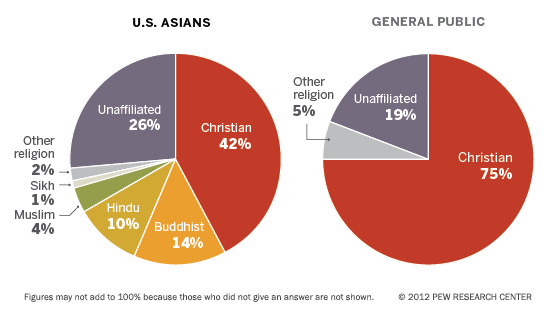Teaching Asian American Islam and Racialization through Film
Using Media to Deconstruct Mainstream Media Stereotypes
“Asian American Muslims”—the phrase itself provokes confusion for many people in the United States, often because there remains a prevalent assumption that Islam is not an Asian American religion. In American worldviews, Islam is most often associated with Middle Eastern culture as a result of a long history of racialization, whereby aspects of social personhood (such as class, ethnicity, and religion) are essentialized and naturalized, transforming “fluid categories of difference into fixed species of otherness” (Silverstein 2005, 364). Thus, teaching Asian American Islam and the many complexities of racialization in post-9/11 America has been both a challenge and a thought-provoking exercise for me. How does one begin to push students to question some of the most basic assumptions about Islam that have been instilled in them for years through powerful images and narratives in the American media and other institutions?
Tackling this challenge has involved turning to the very means that have been used to instill mainstream stereotypes in the first place—namely the media. Exposing undergraduate students to films, images, and social media that portray counter narratives about Islam and Muslim identity has been a compelling pedagogical exercise. Doing so has raised such questions as: What is American Islam? What is Asian American Islam? How do American Muslims embody multiple identities in order to challenge assumptions of American belonging? Here I demonstrate how the use of film not only encourages students to address these questions but also allows them to explore how visual representations of religion, race, and ethnicity shape our understandings of Americanness.
One such film, A Son’s Sacrifice, follows the life of Imran Uddin, a twenty-seven-year-old New Yorker struggling to take over his family’s business. It explores how Imran, the son of a Bangladeshi father and a Puerto Rican mother, endeavors to confront his mixed heritage and gain acceptance from his father’s Muslim community. When you watch the film, you begin to understand how the filmmaker invests in more mainstream images at the beginning of the story, only to later paint a much more nuanced picture. Thus, it is through Imran’s personal journey that students are able to witness how Asian American Muslim communities defy such labels as “moderate,” “fundamentalist,” or “conservative” that are so often used in the media. As one student noted in a response paper: “I felt that those labels became more and more meaningless as the film unfolded. Imran’s community kind of defies labels in the sense that maybe some practices they have may be very traditional. But at the same time, they’re so part and parcel of American culture.” Perhaps what is even more powerful is that the American Muslim story told does not directly address themes of terrorism that are framed in reference to post-9/11 America. Rather, the documentary explores a very humanizing story of struggle and personal growth, moving away from reductionist or exotic portrayals of Islam in America.
Some of the most powerful films I’ve shown in class don’t always focus on Asian American Muslim identity but rather encourage students to deconstruct their own ideas about who Muslims are or what a Muslim can be within a comparative framework of American ethnic and racial belonging. An excellent example is a documentary called New Muslim Cool, which focuses on the life of Hamza Perez, a Puerto Rican-American Muslim convert and rap artist. The film gives an insider’s view of a little-known cultural fusion between Muslims and hip-hop culture, tracing the trajectory of Perez from a drug dealer to his conversion to Islam and his life as a Latino-Muslim rap artist. It highlights the power of pop music and culture to create social change, showing how Perez uses his music to negotiate multiple identities, criticize the government, and facilitate interfaith collaboration.
As students get drawn into Perez’s fascinating world, their assumptions about Latin American identity, Islamic identity, urban street youth, and American music are challenged by Hamza’s embodiment of these various elements. The widespread belief that all Muslims are Middle Eastern, and therefore not American, is immediately called into question by the very American ways in which Perez looks, talks, and performs. Furthermore, the fact that he identifies as Latino and is part of a community of African American and Asian American Muslims pushes students to rethink their notions of what a Muslim looks like, deconstructing dominant images of Muslims in mainstream media that link the religion to terrorists or certain ethnic groups. Students often express surprise at learning that African American or Latino American Muslims exist, and are further intrigued by the kind of music Perez creates and performs. American rap and hip-hop are commonly seen as secular, materialistic, and highly sexualized forms of mainstream cultural expression, deemed worlds apart from conservative or fundamentalist Islamic culture. The coming together of Islam and rap in Perez’s world exposes students to the ways in which urban American youth are using Islam to create a positive hip-hop culture, and it encourages them to look critically at the clash of civilizations rhetoric that divides Islam and the West.
Media-Based Assignments
In addition to employing media to illustrate or raise issues surrounding American Islam, we also consider how film and media have increasingly become important spaces where Americanness as an identity is constantly interrogated and contested. Thus, students engage various media as case studies for thinking about the history of relationships between religion, identity, and popular culture in the United States. To get students to contextualize post-9/11 media commentary on Islam, I assign them the task of examining the history of American film and news in order to find examples of the ways in which certain religious, ethnic, or racial groups are consistently characterized in a particular way. For example, students conduct a content analysis of Hollywood films from the 1950s to the present to track how Asian Americans have been depicted over time. A comparative look at the portrayal of Arab or Middle Eastern people shows patterns of racial and cultural inscription. Through this exercise students come to understand how the subtle and sometimes overtly distorted portrayals of certain ethnic or racial groups in Hollywood movies have helped to validate everything from racial inequality to international foreign policy and war. Furthermore, students learn how Hollywood has served to shape American understandings of themselves through visual and character depictions of the threatening “other,” whether they be African Americans, Asians, Communists, or Arabs.
Another course assignment that puts students behind the camera lens enables them to consider how cultural production is an important site for thinking about and contesting the monopolization of ideas by mainstream American media. I ask students to choose an issue or topic depicted in the media that is being contested by a particular community. I then have them create short films that involve interviewing members of that community in order to grasp and portray alternative perspectives on the topic at hand. The short films are then shown in the classroom and are open to critique and questions by their peers. This exercise is significant in getting students to understand how mediated cultural production has become an important site for struggle by Asian American Muslims as they challenge (mis)representations of Muslim identity and contest the marginalization of Islam from Americanness.
Teaching Asian American Islam through film and media continues to present a number of challenges. While exposing students to films and media that provide alternative perspectives on the lives of American Muslims pushes them to rethink their assumptions about Asian American Islam, I find that it still remains difficult for them to let go of mainstream stereotypes that link the Muslim religion to terrorism. Students find it hard to talk about Muslims and Islam without falling into reductionist terminology, and they continue to inadvertently echo an “us versus them” mentality. I think part of this has to do with their limited exposure to Asian American Muslims in their day-to-day lives. In addition, the number of films or other media that provide meaningful counter narratives on Asian American Islam remain limited. I have also encountered difficulty in finding readings that deal with particular films or that address Muslim media representation in present-day American cultural politics. Despite these challenges, I have found that getting students to think historically about media representation and having them get behind the camera in the class assignment gets them to start considering the ways in which religious and racial subjectivities are shaped and regulated.
 Rabia Kamal, PhD, is an adjunct professor at the University of San Francisco. She received her doctorate in cultural anthropology from the University of Pennsylvania. Professor Kamal’s areas of expertise include cultural and visual anthropology, religious and racial politics in the US, and the use of social media and new technologies for identity formation and political engagement. Her dissertation, entitled “Reimagining Islam: Muslim Cultural Citizenship in the Post-9/11 American Public Sphere,” focuses on the cultural politics of belonging and identity among Asian American and African American Muslim artists and activists in post-9/11 America. Based on three years of ethnographic fieldwork in New York City, it examines the day-to-day experiences and strategic practices of American Muslims whose lives are permeated by discursive and spatial forms of marginalization, and how they are coming together through cultural activism and citizenship practices as a way to simultaneously claim and redefine American belonging.
Rabia Kamal, PhD, is an adjunct professor at the University of San Francisco. She received her doctorate in cultural anthropology from the University of Pennsylvania. Professor Kamal’s areas of expertise include cultural and visual anthropology, religious and racial politics in the US, and the use of social media and new technologies for identity formation and political engagement. Her dissertation, entitled “Reimagining Islam: Muslim Cultural Citizenship in the Post-9/11 American Public Sphere,” focuses on the cultural politics of belonging and identity among Asian American and African American Muslim artists and activists in post-9/11 America. Based on three years of ethnographic fieldwork in New York City, it examines the day-to-day experiences and strategic practices of American Muslims whose lives are permeated by discursive and spatial forms of marginalization, and how they are coming together through cultural activism and citizenship practices as a way to simultaneously claim and redefine American belonging.

